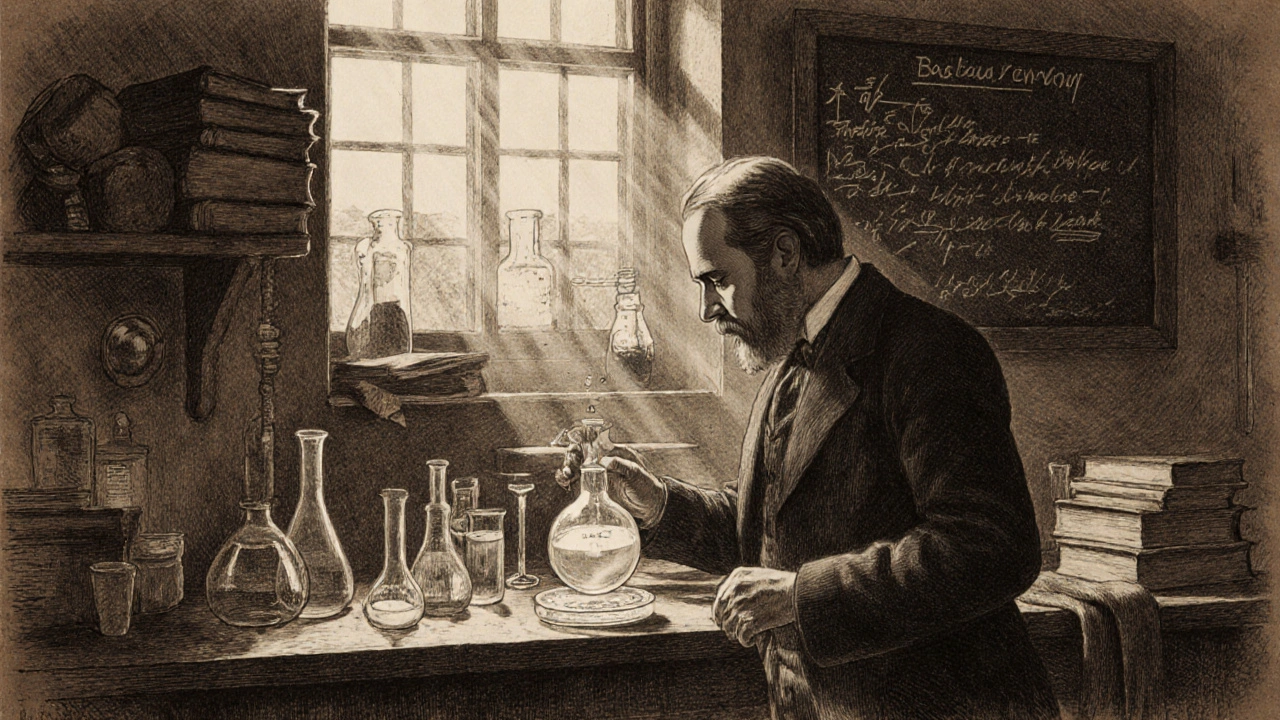Tetanus History: From Ancient Plagues to Modern Vaccines
 Sep, 27 2025
Sep, 27 2025
Tetanus is a serious neurological disease triggered by a potent neurotoxin produced by the bacterium Clostridium tetani. The toxin causes painful, often spasmodic muscle contractions that historically earned the disease the nickname “lockjaw”.
Ancient Observations and Early Terminology
Records from ancient Egypt, China, and Greece mention a mysterious ailment that caused the jaw to lock shut and the body to contort. The Ebers Papyrus (c.1550BC) describes a “spasm of the muscles” after a wound, while Hippocrates (460‑370BC) referred to a "cervical tetanus" that could be fatal if untreated. These early accounts hint at an infectious cause, but the link to soil‑borne bacteria remained unknown for millennia.
Medieval Myths and the Rise of Folk Remedies
During the Middle Ages, tetanus was often blamed on evil spirits or a “poison of the earth”. Healers prescribed herbal poultices, bloodletting, and even prayers. Despite the superstition, one practice-thorough wound cleaning-proved effective, preserving the germ‑theory insight that the disease entered through contaminated injuries.
Scientific Breakthroughs in the 19th Century
The turning point came in 1884 when German bacteriologist Emil von Behring isolated the toxin‑producing organism and demonstrated that immunity could be transferred via serum. VonBehring’s work, later honored with the first Nobel Prize in Physiology or Medicine (1901), laid the foundation for the antitoxin therapy that would save countless lives.
From Antitoxin to Vaccine: The Early 20th Century
In 1890, French scientist Alexandre CélineMérieux produced the first tetanus antitoxin by immunizing horses and harvesting their serum. The antitoxin became a lifesaver on battlefields, especially during World War I, where trench wounds were rife with soil‑borne spores.
However, antitoxin provided only temporary protection and required repeated doses. The quest for a long‑lasting solution led researchers to the concept of a “toxoid”-an inactivated toxin that could safely stimulate the immune system. In 1924, British microbiologist Gladys Duncan created the first tetanus toxoid, marking the birth of modern vaccination.
Vaccination Milestones and Global Campaigns
The 1930s saw widespread adoption of the tetanus toxoid vaccine in industrialized nations, dramatically cutting mortality. Post‑World War II, the U.S. Army introduced the combined diphtheria‑tetanus‑pertussis vaccine (DTP), later refined to DTaP for children and Td for adults. The tetanus vaccine-usually administered as a series of three injections followed by boosters every ten years-became the cornerstone of public‑health immunity.
Parallel to vaccine rollout, the World Health Organization launched the Expanded Programme on Immunization (EPI) in 1974, targeting neonatal tetanus-a devastating form affecting newborns when the umbilical cord is cut with contaminated tools. Mass vaccination of pregnant women and clean‑delivery practices slashed neonatal tetanus deaths from an estimated 787,000 in 1988 to under 30,000 by 2020.

Modern Treatment: Antitoxin Meets Antibiotics
Today, when tetanus does occur, clinicians combine tetanus antitoxin (human tetanus immune globulin) with aggressive wound debridement and a course of metronidazole or penicillin. The antitoxin neutralizes unbound toxin, while antibiotics eradicate the anaerobic bacteria still lurking in the wound.
Supportive care-including sedation, muscle relaxants, and mechanical ventilation-addresses the severe muscle spasms that can last weeks. Early recognition and rapid administration of antitoxin dramatically improve survival rates, now exceeding 95% in high‑resource settings.
Comparing Core Prevention Tools
| Attribute | tetanus vaccine | tetanus antitoxin |
|---|---|---|
| Purpose | Active immunity (prevention) | Passive immunity (treatment) |
| Source | Inactivated toxoid (human/animal‑derived) | Human immune globulin (plasma‑derived) |
| Administration | Intramuscular injection | Intravenous or intramuscular injection |
| Duration of protection | ~10years (booster needed) | Immediate, lasts weeks |
| Typical use case | Routine immunization, travel, occupational risk | Suspected or confirmed tetanus infection |
Related Concepts and Connected Topics
Understanding tetanus opens doors to several allied areas of medicine. Neonatal tetanus illustrates the intersection of infectious disease, obstetric hygiene, and global health policy. The DTaP vaccine links tetanus to diphtheria and pertussis, showcasing how combination immunizations improve compliance. Meanwhile, wound debridement underscores the role of surgical technique in infection control.
The Legacy of Tetanus Research and Future Directions
Centuries of observation, from ancient Egyptian scrolls to modern molecular genetics, have turned tetanus from a feared curse into a preventable disease. Current research focuses on improving vaccine stability for low‑resource settings, developing single‑dose formulations, and exploring monoclonal antibodies that could replace traditional antitoxin.
As antibiotic resistance grows, the medical community is re‑evaluating the role of metronidazole versus newer agents. Meanwhile, genome‑editing tools like CRISPR are being investigated to disrupt the tetanus toxin gene in Clostridium tetani, potentially rendering the bacterium harmless.
Quick Reference Checklist
- Recognize early signs: jaw stiffness, neck pain, generalized muscle spasms.
- Assess wound depth and contamination risk.
- Administer tetanus vaccine if patient’s series is incomplete or if >5years since last dose.
- Give tetanus antitoxin for dirty wounds in inadequately immunized individuals.
- Start antibiotics (metronidazole 500mg IV q8h) and provide supportive care.

Frequently Asked Questions
What causes tetanus?
Tetanus is caused by the neurotoxin produced by Clostridium tetani, an anaerobic bacterium that thrives in soil and enters the body through deep or dirty wounds.
How is tetanus different from a normal muscle spasm?
A typical muscle spasm is brief and localized, whereas tetanus causes sustained, painful contractions that can affect the whole body, often beginning with the jaw (lockjaw) and spreading to the neck, torso, and limbs.
When should I get a tetanus booster?
Adults should receive a Td or Tdap booster every 10years. If you sustain a puncture wound and it’s been more than 5years since your last dose, a booster is recommended.
Can antibiotics prevent tetanus?
Antibiotics help eliminate the bacteria but do not neutralize the toxin already released. That’s why antitoxin (human tetanus immune globulin) is essential alongside antibiotics for suspected infections.
What is neonatal tetanus and how can it be prevented?
Neonatal tetanus occurs when newborns are exposed to the toxin through contaminated umbilical cord cuttings. Vaccinating pregnant women and ensuring clean delivery practices virtually eliminate the disease.
Is there a cure for tetanus?
There is no cure that removes the toxin once it binds to nerves. Treatment focuses on neutralizing any free toxin with antitoxin, controlling symptoms, and eradicating the bacteria.
Why is tetanus still a concern in modern medicine?
Because the bacterium’s spores persist in the environment for decades, any breach in wound care or lapses in vaccination can trigger infection. In low‑resource regions, limited access to vaccines and sterile delivery tools keeps tetanus a public‑health threat.

Justin Channell
September 27, 2025 AT 15:23Great rundown on tetanus history 🚀 Keep learning, you’re doing awesome! Remember, every shot is a step toward safety 😊
Basu Dev
October 4, 2025 AT 08:30The modern tetanus vaccine traces its roots to the pioneering work of Emil von Behring, whose isolation of the toxin in the late 19th century laid the scientific foundation for immunological intervention. Von Behring’s antiserum demonstrated that passive immunity could neutralize circulating toxin, a concept that was later refined into active immunization strategies. In the early 20th century, Alexandre Céline Mérieux’s production of horse‑derived antitoxin provided an immediate therapeutic option for wounded soldiers in World War I. However, clinicians quickly recognized that antitoxin conferred only temporary protection and required repeated administrations. This limitation spurred research into inactivating the toxin while preserving its immunogenic properties, leading to the development of the tetanus toxoid. Gladys Duncan’s 1924 toxoid formulation represented a crucial breakthrough because it could safely induce long‑lasting active immunity without causing disease. The introduction of the toxoid into national immunization programs during the 1930s dramatically reduced tetanus mortality in industrialized nations. Post‑World War II, the combined diphtheria‑tetanus‑pertussis vaccine (DTP) streamlined childhood immunization schedules and improved adherence. The subsequent refinement to DTaP for children and Td for adults addressed concerns about reactogenicity while maintaining protective efficacy. Worldwide, the World Health Organization’s Expanded Programme on Immunization, launched in 1974, integrated tetanus toxoid into routine schedules, especially targeting maternal immunization to prevent neonatal tetanus. Mass vaccination of pregnant women, coupled with clean‑delivery practices, reduced global neonatal tetanus deaths from hundreds of thousands to under thirty thousand by 2020. Contemporary treatment protocols combine human tetanus immune globulin with aggressive wound debridement and antibiotics such as metronidazole, reflecting a dual strategy of toxin neutralization and bacterial eradication. Supportive care, including muscle relaxants and mechanical ventilation when needed, has pushed survival rates above ninety‑five percent in high‑resource settings. Ongoing research focuses on improving vaccine thermostability, exploring single‑dose regimens, and developing monoclonal antibodies that could eventually replace traditional antitoxin preparations. Additionally, genome‑editing technologies such as CRISPR are being investigated to disrupt the tetanus toxin gene in Clostridium tetani, offering a potential long‑term solution to eliminate the pathogen’s virulence.
Krysta Howard
October 11, 2025 AT 01:36While the historical overview is thorough, it glosses over the socioeconomic barriers that still impede vaccine access in low‑income regions 😐 Addressing distribution logistics and cultural hesitancy remains as crucial as the scientific milestones you highlighted. Moreover, integrating modern molecular approaches could accelerate next‑generation vaccine development.
Elizabeth Post
October 17, 2025 AT 18:43Your summary captures the key milestones nicely; it’s a solid reference for anyone looking to understand tetanus prevention.
Brandon Phipps
October 24, 2025 AT 11:50Reading the extensive timeline reminded me just how iterative scientific progress truly is, especially when you consider the trial‑and‑error phases that preceded each major breakthrough. The early reliance on horse‑derived antitoxin, for instance, illustrates both the ingenuity of the era and the ethical concerns that eventually prompted a shift toward human‑based preparations. When the toxoid was finally introduced, it didn’t instantly eradicate tetanus; rather, it required rigorous field trials to determine optimal dosing schedules and booster intervals. The adoption of combined vaccines like DTP further streamlined public health campaigns, reducing the number of injections children needed to receive. It’s also worth noting that the success of maternal immunization programs hinged on community outreach and education, not just on the availability of the vaccine itself. In many low‑resource settings, cold‑chain failures still compromise vaccine potency, underscoring the need for thermostable formulations. The recent push toward single‑dose regimens could dramatically simplify logistics and improve coverage rates. Additionally, the exploration of monoclonal antibodies as a replacement for traditional antitoxin represents an exciting convergence of immunology and biotechnology. CRISPR‑mediated attenuation of toxin genes is still in its infancy, but it holds promise for a future where the pathogen’s virulence is permanently neutralized. Ultimately, the history you outlined serves as a reminder that combating infectious diseases demands a blend of scientific rigor, infrastructural investment, and cultural sensitivity.
yogesh Bhati
October 31, 2025 AT 03:56i cant help but think that tetanus is like the universe reminding us that even the smallest spore can have a massive impact on our lives, kinda like how a single bad decision can echo forever. its amazing that ancient scribes felt the lockjaw but had no clue about the soil bacteria, yet they still tried herbal poultices-showing human curiosity never dies. if we keep tinkering with the toxin gene like a modern alchemist, maybe one day we wont need any shots at all, just a clean wound and good luck! lol
Akinde Tope Henry
November 6, 2025 AT 21:03Tetanus vaccine saves lives
Brian Latham
November 13, 2025 AT 14:10Looks decent but could use more on modern challenges.
Barbara Todd
November 20, 2025 AT 07:16I’m intrigued by how CRISPR could change the tetanus landscape, especially regarding long‑term toxin suppression.
nica torres
November 27, 2025 AT 00:23Awesome post! Keep sharing these deep dives, they really fire up the brain and inspire us to stay vaccinated! 🙌
Dean Marrinan
December 3, 2025 AT 17:30Wow, a whole saga from ancient lockjaw to high‑tech CRISPR-because apparently tetanus needed a Hollywood sequel 🎬🦠. Good thing we’ve got vaccines, otherwise history would repeat itself faster than a bad rerun!
Oluseyi Anani
December 9, 2025 AT 14:23Actually, the reduction in neonatal tetanus was also driven by the WHO’s push for clean delivery kits, not just maternal vaccination, which shows that a multifaceted approach is essential for disease eradication.